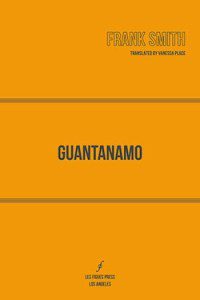
“We are going to ask you some questions,” an interrogator in Frank Smith’s Guantanamo says, “so we can better understand your story.”
This is a seemingly innocuous statement, even a sympathetic one. But it is a dangerous one, because in its tone and intention, it radically upends the relationship between the storyteller and his listener. The power structure ought to be very simple: the storyteller possesses the tale, and imparts it to an audience. One has the original, and the other creates, upon hearing it, a copy in their own minds. In a way, this is how a community is formed: through a sharing of stories.
But the dynamics of an interrogation result in a complete power shift: a story is no longer something to be shared or accepted, but something to be coerced, questioned, tested, and enslaved. With power now located in the interrogator’s hands, how can the speaker redeem himself? Tell the truth, or convince the interrogator. It will never be clear whether those two goals are identical in execution, or mutually exclusive. The punishment for failure would be torture. And without knowing the facts, it is unclear whether we as bystanders should trust the skeptical interrogators, or trust the exhausted detainees of the Guantanamo Bay detention camp.
Guantanamo is a strange book. Like its author, Frank Smith, it is not actually English. Notwithstanding his Anglo-Saxon name, the author is originally French, and wrote the original text of Guantanamo by translating and transforming and interpolating declassified Pentagon documents into French. The result is a new kind of original that bears some traces of its English origins, but remains deeply French in its particular syntax and vocabulary. Following in the same vein, Vanessa Place’s translation of this book is not a restoration of the original text. “Smith provided me with copies of the interrogation transcripts that he had worked with,” she explains in her Translator’s Note at the end of the book, but “I decided not to look at them.” In so doing, she made her translation process into an interrogation not unlike the ones enacted in the book’s pages. One can almost imagine her facing the French text in a small and windowless room, trying to bring forth a logical English text in the absence of any reality or original.
This is a great risk for any translator to take, but it serves this particular book well. Much is withheld. In some sections, who is asking and who is answering are clearly marked. In others, only paragraph breaks distinguish one voice from another. And then there are chapters that break away from the question-and-answer format of interrogation documents into a strange sort of disindividuated poetry:
We are the interrogator, we are the interrogated. / We ask a question, we answer the question asked. / We ask a second question, we answer the second question asked . . . / We ask questions, we do not answer questions. / We interrogate the interrogated, the interrogated answers the interrogator. /The interrogator questions the interrogated, we answer the interrogator.
Vanessa Place’s translation shifts among various ways of referring to people: by their labels as “interrogator” or “interrogated,” as “we,” as “they,” as “he” or “she,” as “one,” sometimes with no pronoun at all. In French, as the text on the left-hand pages shows, all of these manners of reference often appear as the same French pronoun: “on.” Her decision to translate that single word—which mostly reads fluidly and logically in the French text—in so many different ways is a decision to defamiliarize language’s most fundamental components, and to break apart the divide between “us” and “them.” As we keep reading, this manner of translation draws attention to the inability of language to accurately express reality.

There are moments when the text becomes truly foreign, when we realize we are looking at a copy of a copy of a copy. Most memorably, a translator’s voice suddenly appears during an interrogation: “Translator: Excuse me, could I clarify this? Because yesterday, someone said ‘military,’ but meant to say ‘police’ . . . [The translator determines that this was police training, not military.]” It is an intrusion that reminds us that, even if we considered the government-issued transcripts an original, they would themselves be records of a conversation that happened half in English and half in translation from another language—most likely in Arabic or Pashto. It is a subtle but crucial detail, one that recurs when it is noted, near the book’s end: “[The detainee answers this question in good English.]” In such a light, attempting to pin down a person based on their words and in the absence of any verifiable reality becomes even more fraught with possible mistakes.
If we were to perceive Guantanamo as an exercise in language and translation, it would be interesting in its own right. But its title, which in this day and climate carries as much political baggage as “Hiroshima” or “Ferguson,” indicates that Frank Smith’s aims are much broader and much sharper. Guantanamo was published in French by Editions du Seuil in 2010, eight years after the Guantanamo Bay detention camp was opened. The declassified documents he worked with had been created several years prior to publication, and Barack Obama moved to close the camp in 2013—but little has changed since then. Earlier this month, the New York Times published a scathing exposé on the prison’s decaying condition and the government’s refusal to move these prisoners to safer (and higher-security) prisons—not to mention the three-million-dollar annual price tag for each prisoner housed there. Some prisoners have lived there for the entirety of the prison’s twelve-year existence, and their medical concerns have become a serious issue.
This extraordinary cost is even more astonishing given that is not even clear whether all the prisoners at Guantanamo ought to be there. The interrogations presented by Smith, although interpolated from multiple transcripts concerning six detainees, suggest that there were many men being held at Guantanamo who were not involved in terrorist activities at all. One of the detainees asks, exasperatedly, “How could I divide my time? Work to feed my family and, at the same time, receive military and terrorist training for the war. It’s impossible.” Another responds to a question: “I’ve already told you this a hundred times in prior interrogations, but I don’t see any harm repeating my story to you.” Most chillingly, a young detainee responds to a list of charges and claims with clear denials, finally declaring: “I am 26 years old, and up to now, I have never experienced war. I have never touched a gun. I have never suffered from war.”
Guantanamo is clearly designed to instigate further interrogations by its readers. The sheer mass of white space on the pages leads us to wonder what was not set down. A detainee insistently asks: “This young woman, with her five or six charges, I’d like to ask you, where did she dig up this information? Does she have the slightest bit of proof?” Many pages later he receives an answer, but it clarifies nothing: “the clerk presented it on behalf of the government. We do not know exactly where it came from at the moment.” The answer feels particularly unfair because we know that the President of the Tribunal’s evasions will not be punished. If the detainee were to resist providing a clear answer, however, he could suffer the torture that civil-rights lawyers have denounced since the Bush years—including waterboarding.
Is it possible that some of these transcripts were taken while the detainee was being waterboarded? It is a chilling idea, but one that cannot be easily dismissed. The pages of this large book are spare, and include no physical descriptions; nor do the transcripts from which Frank Smith worked. In the book’s second section, there are four times when the interrogated man apparently “Does not respond to question.” We see the next question asked, but we have no way of knowing how these people felt, what they did, how much time passed in between each question and each answer.
Ultimately, the book’s format leads us as readers to sympathize with the detainees and their struggle to convince their interrogators of their innocence. There are no transcripts here from the detainees accused of having aided in the 9/11 attacks; Frank Smith is more interested in the murky area where the interrogated might be equally as innocent as the interrogator. The line grows increasingly blurred between the two camps: “We state that they reportedly said that we served as governor of the Narang district while the Taliban was in power.” (The French is even murkier: “On dit qu’on aurait declaré avoir office comme gouverneur . . .”)
Who actually holds the power in the interrogation room? “We are going to ask you some questions,” the interrogator asks. But the interrogated is free not to answer, or free to lie, or free to tell the truth. If he knows the rules, he can shape his fate howsoever he wishes. In the book’s final section, the detainee mysteriously says, “I would like to go to the United States. To go to the United States, this is what I wish for most in the world.” The statement is at once sincere and ironic: sincere in the detainee’s wish for freedom, and ironic, because the detainee already speaks on American soil, under the care of the American government. Beyond sincerity and irony, he is asking for sympathy.
How strange it is that this sympathy should come through the careful translation and rearrangement of a French author’s words. It is as if we had to become like these detainees, taken away from our homelands and held in unfamiliar places, buoyed only by our hope that the truth might bring us back home.




